Implementing Cost Leadership Strategy in BA: Targets and Timescales
VerifiedAdded on 2019/12/04
|12
|3335
|332
Essay
AI Summary
This report presents a cost leadership strategy implemented by British Airways (BA) to reduce overall costs and improve competitiveness. BA aimed to reduce production costs by 5% in six months, promotional costs by 4% in three months, and overall costs by 10% within one year. Initially, the airline successfully reduced production costs by 4% in two months and promotional costs by 4% in one month. As a result, the cost of production decreased by 8%, enabling BA to lower fares and increase demand in the market.
Contribute Materials
Your contribution can guide someone’s learning journey. Share your
documents today.
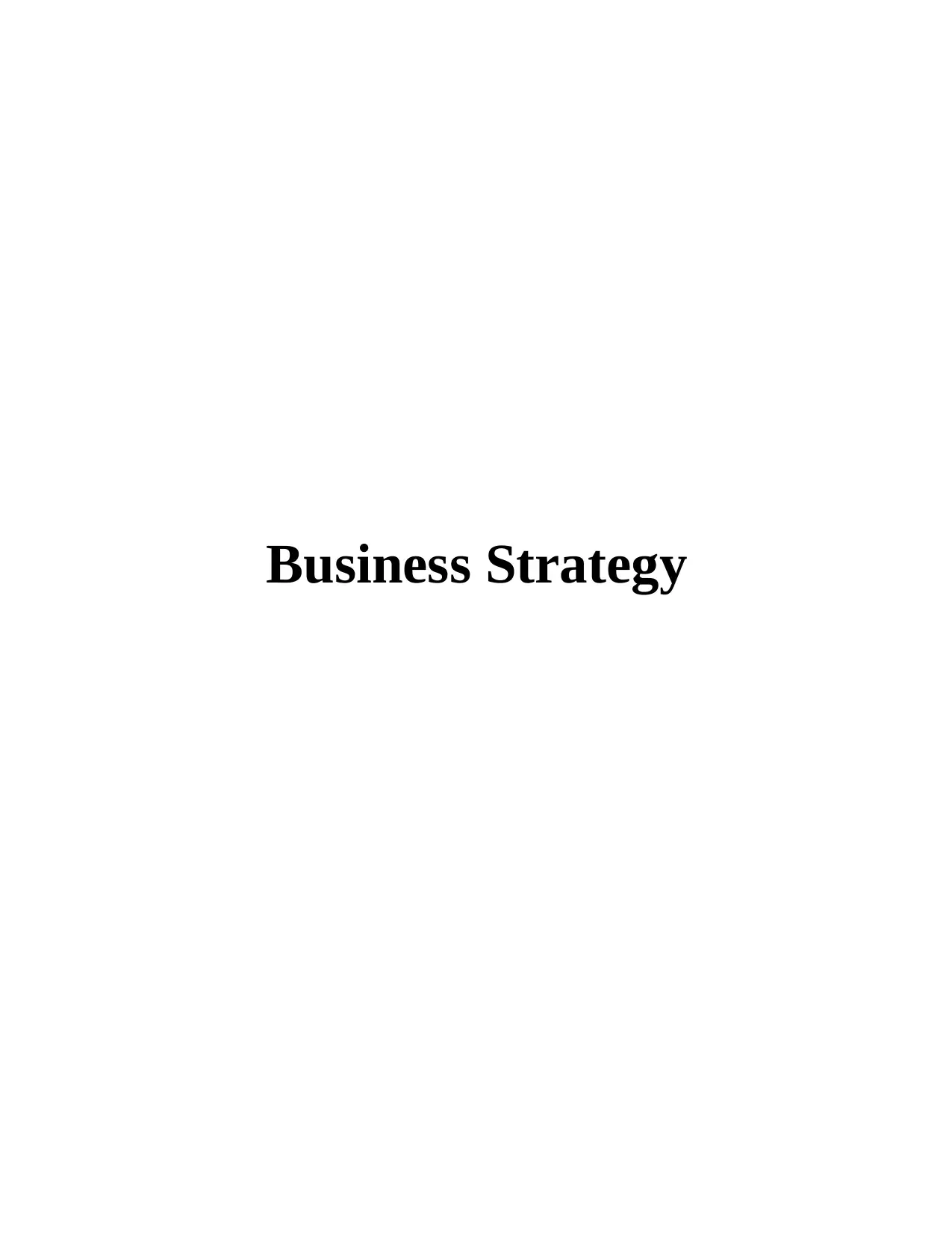
Business Strategy
Secure Best Marks with AI Grader
Need help grading? Try our AI Grader for instant feedback on your assignments.
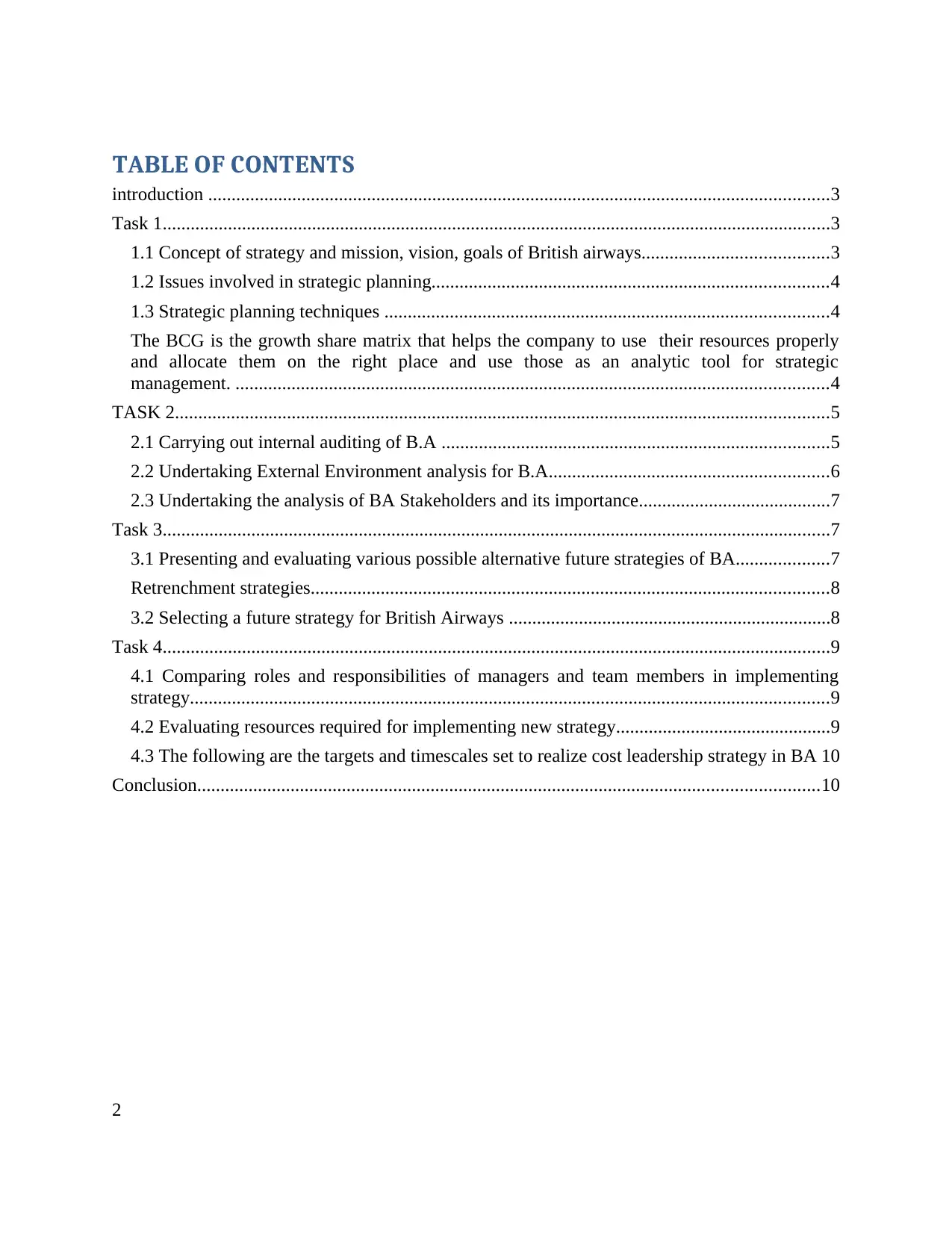
TABLE OF CONTENTS
introduction .....................................................................................................................................3
Task 1...............................................................................................................................................3
1.1 Concept of strategy and mission, vision, goals of British airways........................................3
1.2 Issues involved in strategic planning.....................................................................................4
1.3 Strategic planning techniques ...............................................................................................4
The BCG is the growth share matrix that helps the company to use their resources properly
and allocate them on the right place and use those as an analytic tool for strategic
management. ...............................................................................................................................4
TASK 2............................................................................................................................................5
2.1 Carrying out internal auditing of B.A ...................................................................................5
2.2 Undertaking External Environment analysis for B.A............................................................6
2.3 Undertaking the analysis of BA Stakeholders and its importance.........................................7
Task 3...............................................................................................................................................7
3.1 Presenting and evaluating various possible alternative future strategies of BA....................7
Retrenchment strategies...............................................................................................................8
3.2 Selecting a future strategy for British Airways .....................................................................8
Task 4...............................................................................................................................................9
4.1 Comparing roles and responsibilities of managers and team members in implementing
strategy.........................................................................................................................................9
4.2 Evaluating resources required for implementing new strategy..............................................9
4.3 The following are the targets and timescales set to realize cost leadership strategy in BA 10
Conclusion.....................................................................................................................................10
2
introduction .....................................................................................................................................3
Task 1...............................................................................................................................................3
1.1 Concept of strategy and mission, vision, goals of British airways........................................3
1.2 Issues involved in strategic planning.....................................................................................4
1.3 Strategic planning techniques ...............................................................................................4
The BCG is the growth share matrix that helps the company to use their resources properly
and allocate them on the right place and use those as an analytic tool for strategic
management. ...............................................................................................................................4
TASK 2............................................................................................................................................5
2.1 Carrying out internal auditing of B.A ...................................................................................5
2.2 Undertaking External Environment analysis for B.A............................................................6
2.3 Undertaking the analysis of BA Stakeholders and its importance.........................................7
Task 3...............................................................................................................................................7
3.1 Presenting and evaluating various possible alternative future strategies of BA....................7
Retrenchment strategies...............................................................................................................8
3.2 Selecting a future strategy for British Airways .....................................................................8
Task 4...............................................................................................................................................9
4.1 Comparing roles and responsibilities of managers and team members in implementing
strategy.........................................................................................................................................9
4.2 Evaluating resources required for implementing new strategy..............................................9
4.3 The following are the targets and timescales set to realize cost leadership strategy in BA 10
Conclusion.....................................................................................................................................10
2
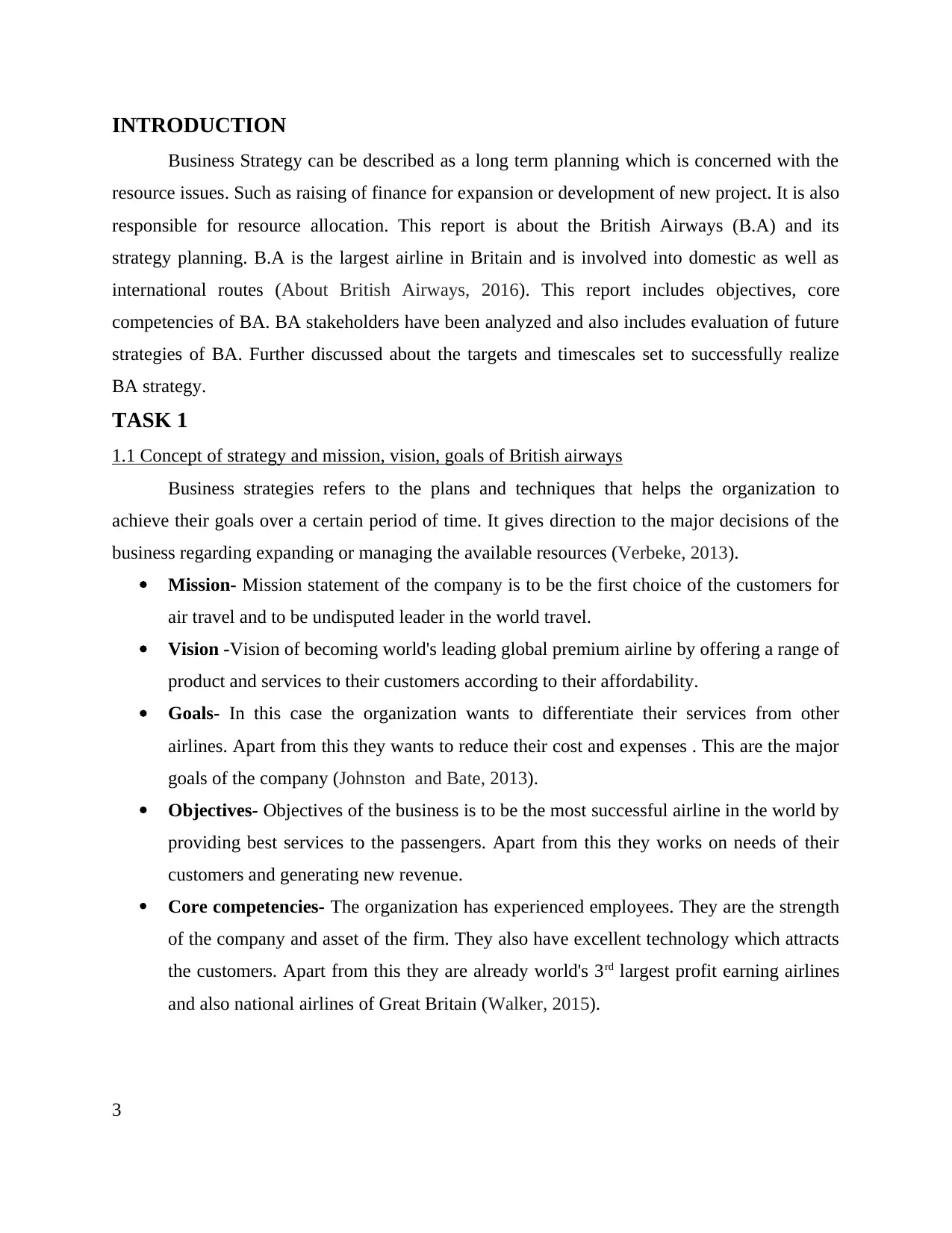
INTRODUCTION
Business Strategy can be described as a long term planning which is concerned with the
resource issues. Such as raising of finance for expansion or development of new project. It is also
responsible for resource allocation. This report is about the British Airways (B.A) and its
strategy planning. B.A is the largest airline in Britain and is involved into domestic as well as
international routes (About British Airways, 2016). This report includes objectives, core
competencies of BA. BA stakeholders have been analyzed and also includes evaluation of future
strategies of BA. Further discussed about the targets and timescales set to successfully realize
BA strategy.
TASK 1
1.1 Concept of strategy and mission, vision, goals of British airways
Business strategies refers to the plans and techniques that helps the organization to
achieve their goals over a certain period of time. It gives direction to the major decisions of the
business regarding expanding or managing the available resources (Verbeke, 2013).
Mission- Mission statement of the company is to be the first choice of the customers for
air travel and to be undisputed leader in the world travel.
Vision -Vision of becoming world's leading global premium airline by offering a range of
product and services to their customers according to their affordability.
Goals- In this case the organization wants to differentiate their services from other
airlines. Apart from this they wants to reduce their cost and expenses . This are the major
goals of the company (Johnston and Bate, 2013).
Objectives- Objectives of the business is to be the most successful airline in the world by
providing best services to the passengers. Apart from this they works on needs of their
customers and generating new revenue.
Core competencies- The organization has experienced employees. They are the strength
of the company and asset of the firm. They also have excellent technology which attracts
the customers. Apart from this they are already world's 3rd largest profit earning airlines
and also national airlines of Great Britain (Walker, 2015).
3
Business Strategy can be described as a long term planning which is concerned with the
resource issues. Such as raising of finance for expansion or development of new project. It is also
responsible for resource allocation. This report is about the British Airways (B.A) and its
strategy planning. B.A is the largest airline in Britain and is involved into domestic as well as
international routes (About British Airways, 2016). This report includes objectives, core
competencies of BA. BA stakeholders have been analyzed and also includes evaluation of future
strategies of BA. Further discussed about the targets and timescales set to successfully realize
BA strategy.
TASK 1
1.1 Concept of strategy and mission, vision, goals of British airways
Business strategies refers to the plans and techniques that helps the organization to
achieve their goals over a certain period of time. It gives direction to the major decisions of the
business regarding expanding or managing the available resources (Verbeke, 2013).
Mission- Mission statement of the company is to be the first choice of the customers for
air travel and to be undisputed leader in the world travel.
Vision -Vision of becoming world's leading global premium airline by offering a range of
product and services to their customers according to their affordability.
Goals- In this case the organization wants to differentiate their services from other
airlines. Apart from this they wants to reduce their cost and expenses . This are the major
goals of the company (Johnston and Bate, 2013).
Objectives- Objectives of the business is to be the most successful airline in the world by
providing best services to the passengers. Apart from this they works on needs of their
customers and generating new revenue.
Core competencies- The organization has experienced employees. They are the strength
of the company and asset of the firm. They also have excellent technology which attracts
the customers. Apart from this they are already world's 3rd largest profit earning airlines
and also national airlines of Great Britain (Walker, 2015).
3
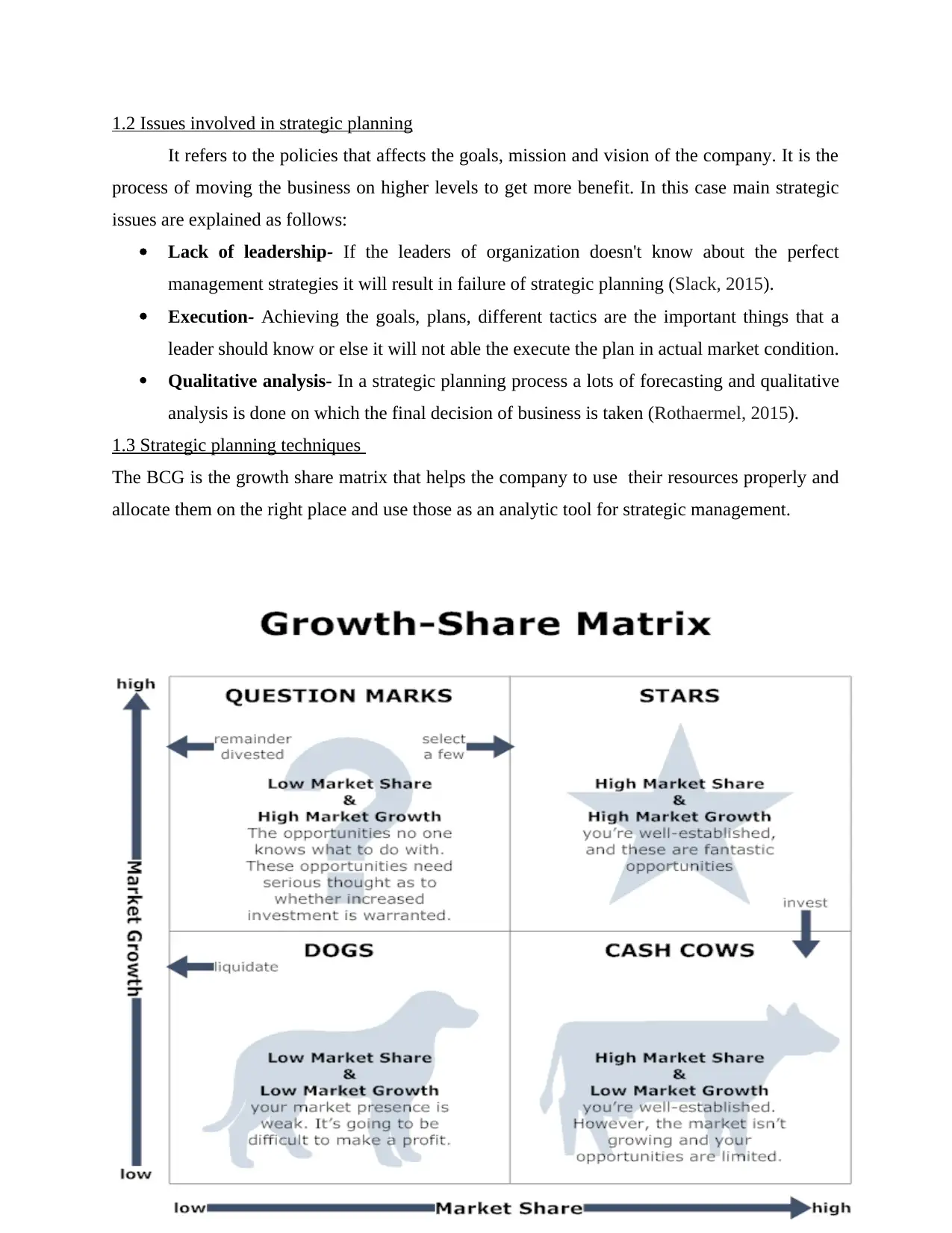
1.2 Issues involved in strategic planning
It refers to the policies that affects the goals, mission and vision of the company. It is the
process of moving the business on higher levels to get more benefit. In this case main strategic
issues are explained as follows:
Lack of leadership- If the leaders of organization doesn't know about the perfect
management strategies it will result in failure of strategic planning (Slack, 2015).
Execution- Achieving the goals, plans, different tactics are the important things that a
leader should know or else it will not able the execute the plan in actual market condition.
Qualitative analysis- In a strategic planning process a lots of forecasting and qualitative
analysis is done on which the final decision of business is taken (Rothaermel, 2015).
1.3 Strategic planning techniques
The BCG is the growth share matrix that helps the company to use their resources properly and
allocate them on the right place and use those as an analytic tool for strategic management.
4
It refers to the policies that affects the goals, mission and vision of the company. It is the
process of moving the business on higher levels to get more benefit. In this case main strategic
issues are explained as follows:
Lack of leadership- If the leaders of organization doesn't know about the perfect
management strategies it will result in failure of strategic planning (Slack, 2015).
Execution- Achieving the goals, plans, different tactics are the important things that a
leader should know or else it will not able the execute the plan in actual market condition.
Qualitative analysis- In a strategic planning process a lots of forecasting and qualitative
analysis is done on which the final decision of business is taken (Rothaermel, 2015).
1.3 Strategic planning techniques
The BCG is the growth share matrix that helps the company to use their resources properly and
allocate them on the right place and use those as an analytic tool for strategic management.
4
Secure Best Marks with AI Grader
Need help grading? Try our AI Grader for instant feedback on your assignments.
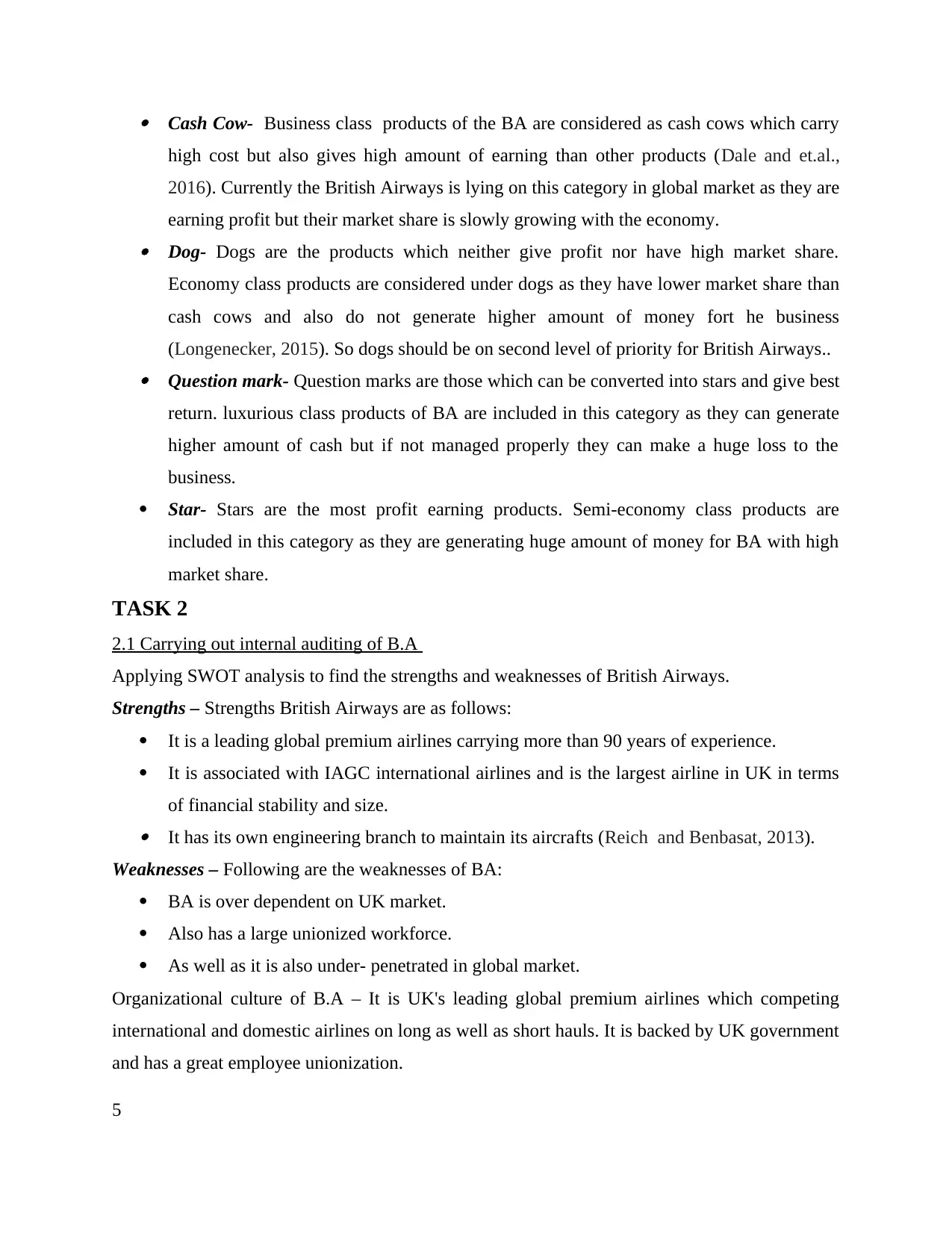
Cash Cow- Business class products of the BA are considered as cash cows which carry
high cost but also gives high amount of earning than other products (Dale and et.al.,
2016). Currently the British Airways is lying on this category in global market as they are
earning profit but their market share is slowly growing with the economy. Dog- Dogs are the products which neither give profit nor have high market share.
Economy class products are considered under dogs as they have lower market share than
cash cows and also do not generate higher amount of money fort he business
(Longenecker, 2015). So dogs should be on second level of priority for British Airways.. Question mark- Question marks are those which can be converted into stars and give best
return. luxurious class products of BA are included in this category as they can generate
higher amount of cash but if not managed properly they can make a huge loss to the
business.
Star- Stars are the most profit earning products. Semi-economy class products are
included in this category as they are generating huge amount of money for BA with high
market share.
TASK 2
2.1 Carrying out internal auditing of B.A
Applying SWOT analysis to find the strengths and weaknesses of British Airways.
Strengths – Strengths British Airways are as follows:
It is a leading global premium airlines carrying more than 90 years of experience.
It is associated with IAGC international airlines and is the largest airline in UK in terms
of financial stability and size. It has its own engineering branch to maintain its aircrafts (Reich and Benbasat, 2013).
Weaknesses – Following are the weaknesses of BA:
BA is over dependent on UK market.
Also has a large unionized workforce.
As well as it is also under- penetrated in global market.
Organizational culture of B.A – It is UK's leading global premium airlines which competing
international and domestic airlines on long as well as short hauls. It is backed by UK government
and has a great employee unionization.
5
high cost but also gives high amount of earning than other products (Dale and et.al.,
2016). Currently the British Airways is lying on this category in global market as they are
earning profit but their market share is slowly growing with the economy. Dog- Dogs are the products which neither give profit nor have high market share.
Economy class products are considered under dogs as they have lower market share than
cash cows and also do not generate higher amount of money fort he business
(Longenecker, 2015). So dogs should be on second level of priority for British Airways.. Question mark- Question marks are those which can be converted into stars and give best
return. luxurious class products of BA are included in this category as they can generate
higher amount of cash but if not managed properly they can make a huge loss to the
business.
Star- Stars are the most profit earning products. Semi-economy class products are
included in this category as they are generating huge amount of money for BA with high
market share.
TASK 2
2.1 Carrying out internal auditing of B.A
Applying SWOT analysis to find the strengths and weaknesses of British Airways.
Strengths – Strengths British Airways are as follows:
It is a leading global premium airlines carrying more than 90 years of experience.
It is associated with IAGC international airlines and is the largest airline in UK in terms
of financial stability and size. It has its own engineering branch to maintain its aircrafts (Reich and Benbasat, 2013).
Weaknesses – Following are the weaknesses of BA:
BA is over dependent on UK market.
Also has a large unionized workforce.
As well as it is also under- penetrated in global market.
Organizational culture of B.A – It is UK's leading global premium airlines which competing
international and domestic airlines on long as well as short hauls. It is backed by UK government
and has a great employee unionization.
5
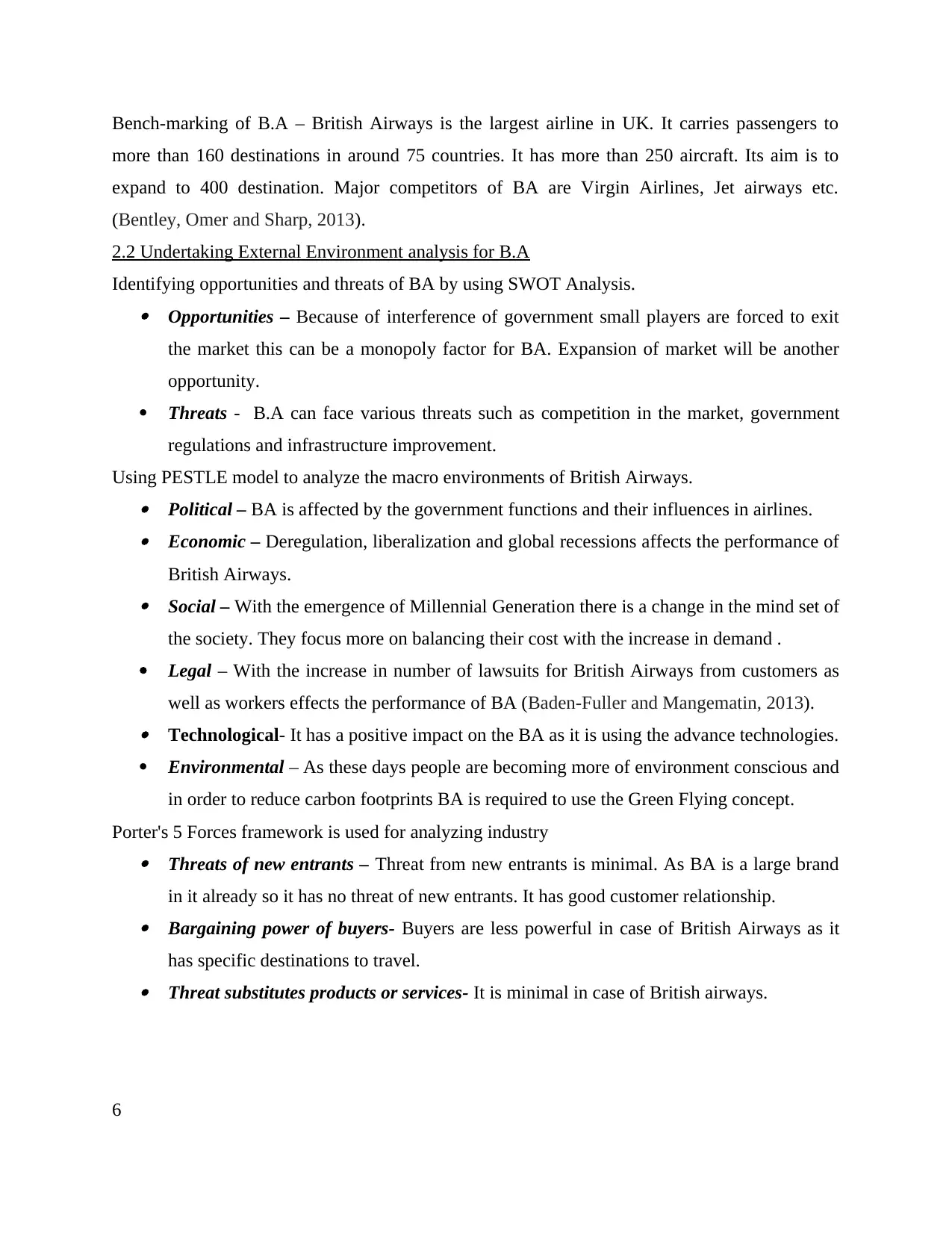
Bench-marking of B.A – British Airways is the largest airline in UK. It carries passengers to
more than 160 destinations in around 75 countries. It has more than 250 aircraft. Its aim is to
expand to 400 destination. Major competitors of BA are Virgin Airlines, Jet airways etc.
(Bentley, Omer and Sharp, 2013).
2.2 Undertaking External Environment analysis for B.A
Identifying opportunities and threats of BA by using SWOT Analysis. Opportunities – Because of interference of government small players are forced to exit
the market this can be a monopoly factor for BA. Expansion of market will be another
opportunity.
Threats - B.A can face various threats such as competition in the market, government
regulations and infrastructure improvement.
Using PESTLE model to analyze the macro environments of British Airways. Political – BA is affected by the government functions and their influences in airlines. Economic – Deregulation, liberalization and global recessions affects the performance of
British Airways. Social – With the emergence of Millennial Generation there is a change in the mind set of
the society. They focus more on balancing their cost with the increase in demand .
Legal – With the increase in number of lawsuits for British Airways from customers as
well as workers effects the performance of BA (Baden-Fuller and Mangematin, 2013). Technological- It has a positive impact on the BA as it is using the advance technologies.
Environmental – As these days people are becoming more of environment conscious and
in order to reduce carbon footprints BA is required to use the Green Flying concept.
Porter's 5 Forces framework is used for analyzing industry Threats of new entrants – Threat from new entrants is minimal. As BA is a large brand
in it already so it has no threat of new entrants. It has good customer relationship. Bargaining power of buyers- Buyers are less powerful in case of British Airways as it
has specific destinations to travel. Threat substitutes products or services- It is minimal in case of British airways.
6
more than 160 destinations in around 75 countries. It has more than 250 aircraft. Its aim is to
expand to 400 destination. Major competitors of BA are Virgin Airlines, Jet airways etc.
(Bentley, Omer and Sharp, 2013).
2.2 Undertaking External Environment analysis for B.A
Identifying opportunities and threats of BA by using SWOT Analysis. Opportunities – Because of interference of government small players are forced to exit
the market this can be a monopoly factor for BA. Expansion of market will be another
opportunity.
Threats - B.A can face various threats such as competition in the market, government
regulations and infrastructure improvement.
Using PESTLE model to analyze the macro environments of British Airways. Political – BA is affected by the government functions and their influences in airlines. Economic – Deregulation, liberalization and global recessions affects the performance of
British Airways. Social – With the emergence of Millennial Generation there is a change in the mind set of
the society. They focus more on balancing their cost with the increase in demand .
Legal – With the increase in number of lawsuits for British Airways from customers as
well as workers effects the performance of BA (Baden-Fuller and Mangematin, 2013). Technological- It has a positive impact on the BA as it is using the advance technologies.
Environmental – As these days people are becoming more of environment conscious and
in order to reduce carbon footprints BA is required to use the Green Flying concept.
Porter's 5 Forces framework is used for analyzing industry Threats of new entrants – Threat from new entrants is minimal. As BA is a large brand
in it already so it has no threat of new entrants. It has good customer relationship. Bargaining power of buyers- Buyers are less powerful in case of British Airways as it
has specific destinations to travel. Threat substitutes products or services- It is minimal in case of British airways.
6
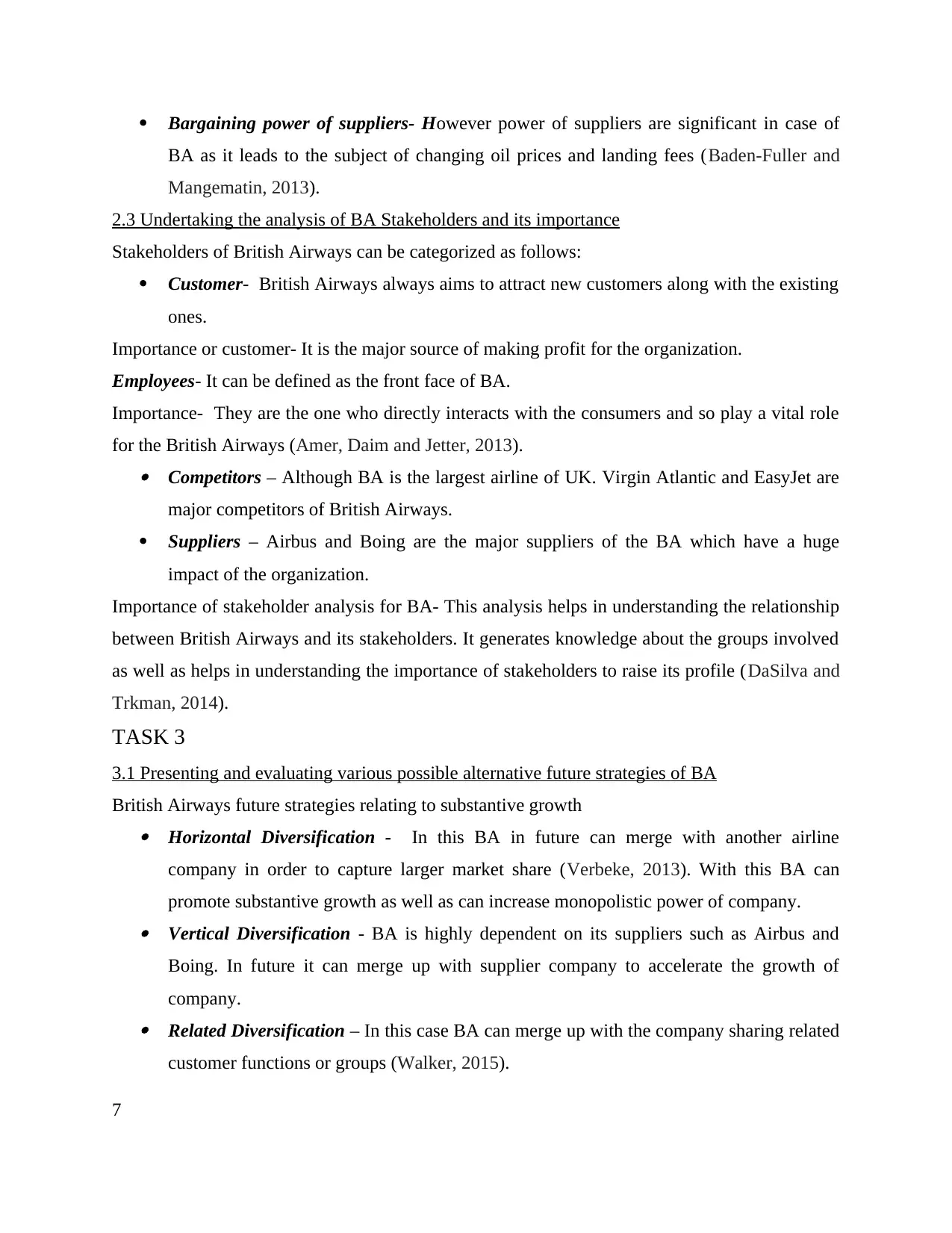
Bargaining power of suppliers- However power of suppliers are significant in case of
BA as it leads to the subject of changing oil prices and landing fees (Baden-Fuller and
Mangematin, 2013).
2.3 Undertaking the analysis of BA Stakeholders and its importance
Stakeholders of British Airways can be categorized as follows:
Customer- British Airways always aims to attract new customers along with the existing
ones.
Importance or customer- It is the major source of making profit for the organization.
Employees- It can be defined as the front face of BA.
Importance- They are the one who directly interacts with the consumers and so play a vital role
for the British Airways (Amer, Daim and Jetter, 2013). Competitors – Although BA is the largest airline of UK. Virgin Atlantic and EasyJet are
major competitors of British Airways.
Suppliers – Airbus and Boing are the major suppliers of the BA which have a huge
impact of the organization.
Importance of stakeholder analysis for BA- This analysis helps in understanding the relationship
between British Airways and its stakeholders. It generates knowledge about the groups involved
as well as helps in understanding the importance of stakeholders to raise its profile (DaSilva and
Trkman, 2014).
TASK 3
3.1 Presenting and evaluating various possible alternative future strategies of BA
British Airways future strategies relating to substantive growth Horizontal Diversification - In this BA in future can merge with another airline
company in order to capture larger market share (Verbeke, 2013). With this BA can
promote substantive growth as well as can increase monopolistic power of company. Vertical Diversification - BA is highly dependent on its suppliers such as Airbus and
Boing. In future it can merge up with supplier company to accelerate the growth of
company. Related Diversification – In this case BA can merge up with the company sharing related
customer functions or groups (Walker, 2015).
7
BA as it leads to the subject of changing oil prices and landing fees (Baden-Fuller and
Mangematin, 2013).
2.3 Undertaking the analysis of BA Stakeholders and its importance
Stakeholders of British Airways can be categorized as follows:
Customer- British Airways always aims to attract new customers along with the existing
ones.
Importance or customer- It is the major source of making profit for the organization.
Employees- It can be defined as the front face of BA.
Importance- They are the one who directly interacts with the consumers and so play a vital role
for the British Airways (Amer, Daim and Jetter, 2013). Competitors – Although BA is the largest airline of UK. Virgin Atlantic and EasyJet are
major competitors of British Airways.
Suppliers – Airbus and Boing are the major suppliers of the BA which have a huge
impact of the organization.
Importance of stakeholder analysis for BA- This analysis helps in understanding the relationship
between British Airways and its stakeholders. It generates knowledge about the groups involved
as well as helps in understanding the importance of stakeholders to raise its profile (DaSilva and
Trkman, 2014).
TASK 3
3.1 Presenting and evaluating various possible alternative future strategies of BA
British Airways future strategies relating to substantive growth Horizontal Diversification - In this BA in future can merge with another airline
company in order to capture larger market share (Verbeke, 2013). With this BA can
promote substantive growth as well as can increase monopolistic power of company. Vertical Diversification - BA is highly dependent on its suppliers such as Airbus and
Boing. In future it can merge up with supplier company to accelerate the growth of
company. Related Diversification – In this case BA can merge up with the company sharing related
customer functions or groups (Walker, 2015).
7
Paraphrase This Document
Need a fresh take? Get an instant paraphrase of this document with our AI Paraphraser
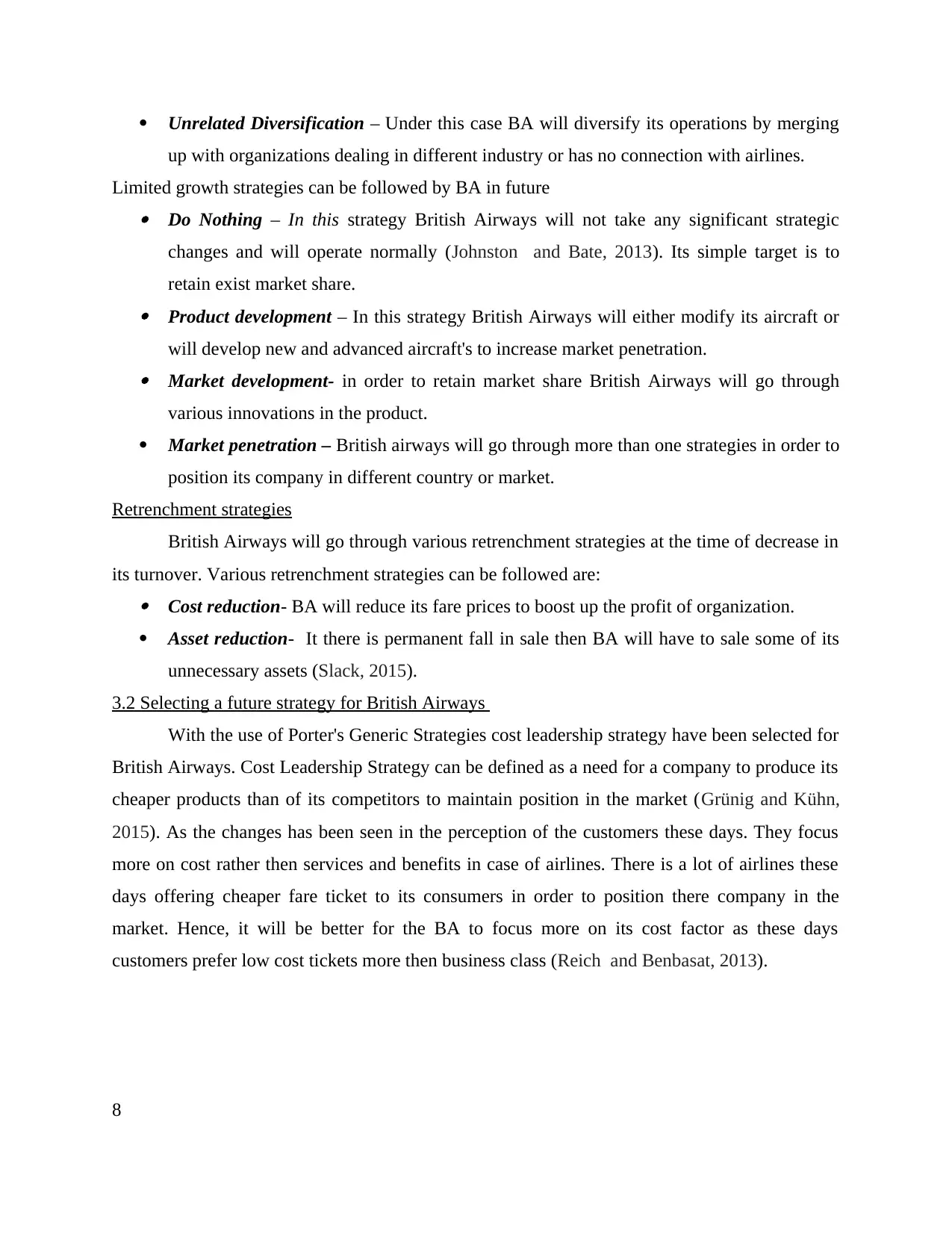
Unrelated Diversification – Under this case BA will diversify its operations by merging
up with organizations dealing in different industry or has no connection with airlines.
Limited growth strategies can be followed by BA in future Do Nothing – In this strategy British Airways will not take any significant strategic
changes and will operate normally (Johnston and Bate, 2013). Its simple target is to
retain exist market share. Product development – In this strategy British Airways will either modify its aircraft or
will develop new and advanced aircraft's to increase market penetration. Market development- in order to retain market share British Airways will go through
various innovations in the product.
Market penetration – British airways will go through more than one strategies in order to
position its company in different country or market.
Retrenchment strategies
British Airways will go through various retrenchment strategies at the time of decrease in
its turnover. Various retrenchment strategies can be followed are: Cost reduction- BA will reduce its fare prices to boost up the profit of organization.
Asset reduction- It there is permanent fall in sale then BA will have to sale some of its
unnecessary assets (Slack, 2015).
3.2 Selecting a future strategy for British Airways
With the use of Porter's Generic Strategies cost leadership strategy have been selected for
British Airways. Cost Leadership Strategy can be defined as a need for a company to produce its
cheaper products than of its competitors to maintain position in the market (Grünig and Kühn,
2015). As the changes has been seen in the perception of the customers these days. They focus
more on cost rather then services and benefits in case of airlines. There is a lot of airlines these
days offering cheaper fare ticket to its consumers in order to position there company in the
market. Hence, it will be better for the BA to focus more on its cost factor as these days
customers prefer low cost tickets more then business class (Reich and Benbasat, 2013).
8
up with organizations dealing in different industry or has no connection with airlines.
Limited growth strategies can be followed by BA in future Do Nothing – In this strategy British Airways will not take any significant strategic
changes and will operate normally (Johnston and Bate, 2013). Its simple target is to
retain exist market share. Product development – In this strategy British Airways will either modify its aircraft or
will develop new and advanced aircraft's to increase market penetration. Market development- in order to retain market share British Airways will go through
various innovations in the product.
Market penetration – British airways will go through more than one strategies in order to
position its company in different country or market.
Retrenchment strategies
British Airways will go through various retrenchment strategies at the time of decrease in
its turnover. Various retrenchment strategies can be followed are: Cost reduction- BA will reduce its fare prices to boost up the profit of organization.
Asset reduction- It there is permanent fall in sale then BA will have to sale some of its
unnecessary assets (Slack, 2015).
3.2 Selecting a future strategy for British Airways
With the use of Porter's Generic Strategies cost leadership strategy have been selected for
British Airways. Cost Leadership Strategy can be defined as a need for a company to produce its
cheaper products than of its competitors to maintain position in the market (Grünig and Kühn,
2015). As the changes has been seen in the perception of the customers these days. They focus
more on cost rather then services and benefits in case of airlines. There is a lot of airlines these
days offering cheaper fare ticket to its consumers in order to position there company in the
market. Hence, it will be better for the BA to focus more on its cost factor as these days
customers prefer low cost tickets more then business class (Reich and Benbasat, 2013).
8
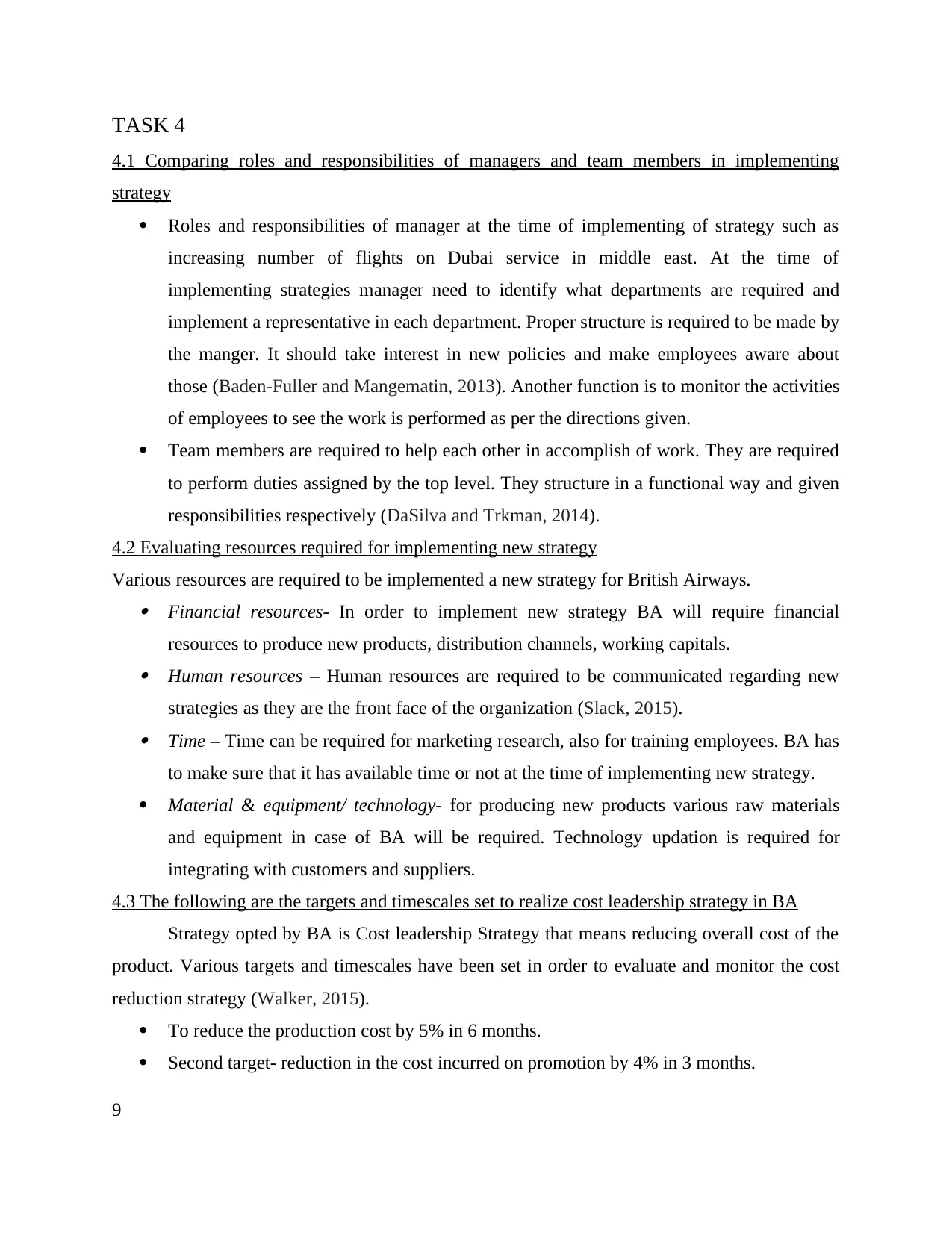
TASK 4
4.1 Comparing roles and responsibilities of managers and team members in implementing
strategy
Roles and responsibilities of manager at the time of implementing of strategy such as
increasing number of flights on Dubai service in middle east. At the time of
implementing strategies manager need to identify what departments are required and
implement a representative in each department. Proper structure is required to be made by
the manger. It should take interest in new policies and make employees aware about
those (Baden-Fuller and Mangematin, 2013). Another function is to monitor the activities
of employees to see the work is performed as per the directions given.
Team members are required to help each other in accomplish of work. They are required
to perform duties assigned by the top level. They structure in a functional way and given
responsibilities respectively (DaSilva and Trkman, 2014).
4.2 Evaluating resources required for implementing new strategy
Various resources are required to be implemented a new strategy for British Airways. Financial resources- In order to implement new strategy BA will require financial
resources to produce new products, distribution channels, working capitals. Human resources – Human resources are required to be communicated regarding new
strategies as they are the front face of the organization (Slack, 2015). Time – Time can be required for marketing research, also for training employees. BA has
to make sure that it has available time or not at the time of implementing new strategy.
Material & equipment/ technology- for producing new products various raw materials
and equipment in case of BA will be required. Technology updation is required for
integrating with customers and suppliers.
4.3 The following are the targets and timescales set to realize cost leadership strategy in BA
Strategy opted by BA is Cost leadership Strategy that means reducing overall cost of the
product. Various targets and timescales have been set in order to evaluate and monitor the cost
reduction strategy (Walker, 2015).
To reduce the production cost by 5% in 6 months.
Second target- reduction in the cost incurred on promotion by 4% in 3 months.
9
4.1 Comparing roles and responsibilities of managers and team members in implementing
strategy
Roles and responsibilities of manager at the time of implementing of strategy such as
increasing number of flights on Dubai service in middle east. At the time of
implementing strategies manager need to identify what departments are required and
implement a representative in each department. Proper structure is required to be made by
the manger. It should take interest in new policies and make employees aware about
those (Baden-Fuller and Mangematin, 2013). Another function is to monitor the activities
of employees to see the work is performed as per the directions given.
Team members are required to help each other in accomplish of work. They are required
to perform duties assigned by the top level. They structure in a functional way and given
responsibilities respectively (DaSilva and Trkman, 2014).
4.2 Evaluating resources required for implementing new strategy
Various resources are required to be implemented a new strategy for British Airways. Financial resources- In order to implement new strategy BA will require financial
resources to produce new products, distribution channels, working capitals. Human resources – Human resources are required to be communicated regarding new
strategies as they are the front face of the organization (Slack, 2015). Time – Time can be required for marketing research, also for training employees. BA has
to make sure that it has available time or not at the time of implementing new strategy.
Material & equipment/ technology- for producing new products various raw materials
and equipment in case of BA will be required. Technology updation is required for
integrating with customers and suppliers.
4.3 The following are the targets and timescales set to realize cost leadership strategy in BA
Strategy opted by BA is Cost leadership Strategy that means reducing overall cost of the
product. Various targets and timescales have been set in order to evaluate and monitor the cost
reduction strategy (Walker, 2015).
To reduce the production cost by 5% in 6 months.
Second target- reduction in the cost incurred on promotion by 4% in 3 months.
9

Third target is to bring the overall reduction in cost by 10% in 1 year.
BA had reduced its production cost to 4% in 2 months and had also reduced the promotion cost
by 4% in 1month. Reduction in promotional as well as production activities had lead over to
decrease in the cost of production of organization. That has resulted in decrease in overall cost of
production by 8% within one year. This has resulted in lowering the fare prices of the BA and
has increase the demand in the market (Johnston and Bate, 2013).
CONCLUSION
This report was about business planning strategies to be implemented on British Airways.
It includes various strategic planning techniques such as BCG. Then various methods had been
applied to find the internal and external factors affecting BA such as SWOT. PESTLE etc.
Alternative future strategies have been evaluated in relation to substantive, limited growth.
Further discussed on targets and timescales set o monitor and evaluating the implemented
strategy.
10
BA had reduced its production cost to 4% in 2 months and had also reduced the promotion cost
by 4% in 1month. Reduction in promotional as well as production activities had lead over to
decrease in the cost of production of organization. That has resulted in decrease in overall cost of
production by 8% within one year. This has resulted in lowering the fare prices of the BA and
has increase the demand in the market (Johnston and Bate, 2013).
CONCLUSION
This report was about business planning strategies to be implemented on British Airways.
It includes various strategic planning techniques such as BCG. Then various methods had been
applied to find the internal and external factors affecting BA such as SWOT. PESTLE etc.
Alternative future strategies have been evaluated in relation to substantive, limited growth.
Further discussed on targets and timescales set o monitor and evaluating the implemented
strategy.
10
Secure Best Marks with AI Grader
Need help grading? Try our AI Grader for instant feedback on your assignments.
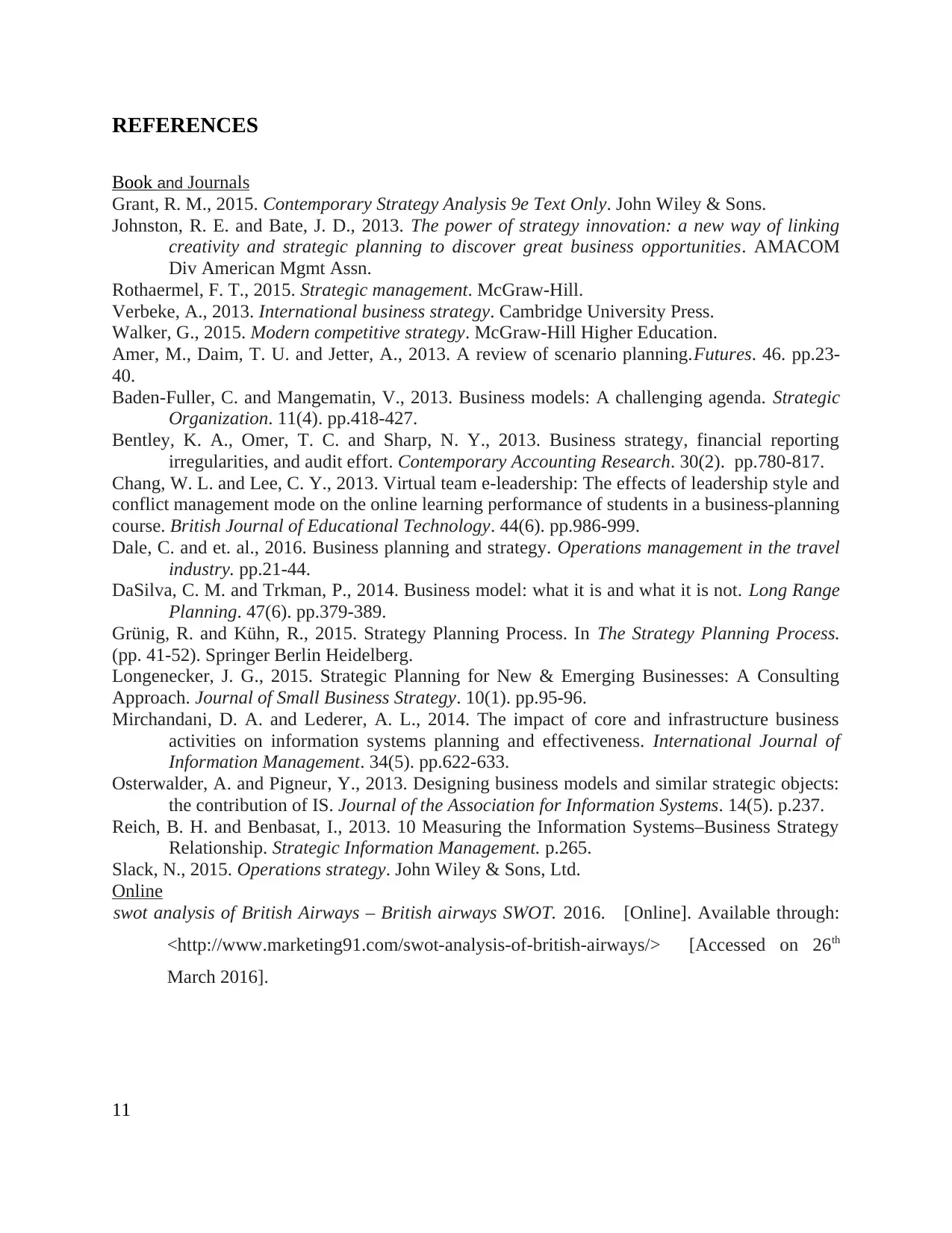
REFERENCES
Book and Journals
Grant, R. M., 2015. Contemporary Strategy Analysis 9e Text Only. John Wiley & Sons.
Johnston, R. E. and Bate, J. D., 2013. The power of strategy innovation: a new way of linking
creativity and strategic planning to discover great business opportunities. AMACOM
Div American Mgmt Assn.
Rothaermel, F. T., 2015. Strategic management. McGraw-Hill.
Verbeke, A., 2013. International business strategy. Cambridge University Press.
Walker, G., 2015. Modern competitive strategy. McGraw-Hill Higher Education.
Amer, M., Daim, T. U. and Jetter, A., 2013. A review of scenario planning.Futures. 46. pp.23-
40.
Baden-Fuller, C. and Mangematin, V., 2013. Business models: A challenging agenda. Strategic
Organization. 11(4). pp.418-427.
Bentley, K. A., Omer, T. C. and Sharp, N. Y., 2013. Business strategy, financial reporting
irregularities, and audit effort. Contemporary Accounting Research. 30(2). pp.780-817.
Chang, W. L. and Lee, C. Y., 2013. Virtual team e‐leadership: The effects of leadership style and
conflict management mode on the online learning performance of students in a business‐planning
course. British Journal of Educational Technology. 44(6). pp.986-999.
Dale, C. and et. al., 2016. Business planning and strategy. Operations management in the travel
industry. pp.21-44.
DaSilva, C. M. and Trkman, P., 2014. Business model: what it is and what it is not. Long Range
Planning. 47(6). pp.379-389.
Grünig, R. and Kühn, R., 2015. Strategy Planning Process. In The Strategy Planning Process.
(pp. 41-52). Springer Berlin Heidelberg.
Longenecker, J. G., 2015. Strategic Planning for New & Emerging Businesses: A Consulting
Approach. Journal of Small Business Strategy. 10(1). pp.95-96.
Mirchandani, D. A. and Lederer, A. L., 2014. The impact of core and infrastructure business
activities on information systems planning and effectiveness. International Journal of
Information Management. 34(5). pp.622-633.
Osterwalder, A. and Pigneur, Y., 2013. Designing business models and similar strategic objects:
the contribution of IS. Journal of the Association for Information Systems. 14(5). p.237.
Reich, B. H. and Benbasat, I., 2013. 10 Measuring the Information Systems–Business Strategy
Relationship. Strategic Information Management. p.265.
Slack, N., 2015. Operations strategy. John Wiley & Sons, Ltd.
Online
swot analysis of British Airways – British airways SWOT. 2016. [Online]. Available through:
<http://www.marketing91.com/swot-analysis-of-british-airways/> [Accessed on 26th
March 2016].
11
Book and Journals
Grant, R. M., 2015. Contemporary Strategy Analysis 9e Text Only. John Wiley & Sons.
Johnston, R. E. and Bate, J. D., 2013. The power of strategy innovation: a new way of linking
creativity and strategic planning to discover great business opportunities. AMACOM
Div American Mgmt Assn.
Rothaermel, F. T., 2015. Strategic management. McGraw-Hill.
Verbeke, A., 2013. International business strategy. Cambridge University Press.
Walker, G., 2015. Modern competitive strategy. McGraw-Hill Higher Education.
Amer, M., Daim, T. U. and Jetter, A., 2013. A review of scenario planning.Futures. 46. pp.23-
40.
Baden-Fuller, C. and Mangematin, V., 2013. Business models: A challenging agenda. Strategic
Organization. 11(4). pp.418-427.
Bentley, K. A., Omer, T. C. and Sharp, N. Y., 2013. Business strategy, financial reporting
irregularities, and audit effort. Contemporary Accounting Research. 30(2). pp.780-817.
Chang, W. L. and Lee, C. Y., 2013. Virtual team e‐leadership: The effects of leadership style and
conflict management mode on the online learning performance of students in a business‐planning
course. British Journal of Educational Technology. 44(6). pp.986-999.
Dale, C. and et. al., 2016. Business planning and strategy. Operations management in the travel
industry. pp.21-44.
DaSilva, C. M. and Trkman, P., 2014. Business model: what it is and what it is not. Long Range
Planning. 47(6). pp.379-389.
Grünig, R. and Kühn, R., 2015. Strategy Planning Process. In The Strategy Planning Process.
(pp. 41-52). Springer Berlin Heidelberg.
Longenecker, J. G., 2015. Strategic Planning for New & Emerging Businesses: A Consulting
Approach. Journal of Small Business Strategy. 10(1). pp.95-96.
Mirchandani, D. A. and Lederer, A. L., 2014. The impact of core and infrastructure business
activities on information systems planning and effectiveness. International Journal of
Information Management. 34(5). pp.622-633.
Osterwalder, A. and Pigneur, Y., 2013. Designing business models and similar strategic objects:
the contribution of IS. Journal of the Association for Information Systems. 14(5). p.237.
Reich, B. H. and Benbasat, I., 2013. 10 Measuring the Information Systems–Business Strategy
Relationship. Strategic Information Management. p.265.
Slack, N., 2015. Operations strategy. John Wiley & Sons, Ltd.
Online
swot analysis of British Airways – British airways SWOT. 2016. [Online]. Available through:
<http://www.marketing91.com/swot-analysis-of-british-airways/> [Accessed on 26th
March 2016].
11
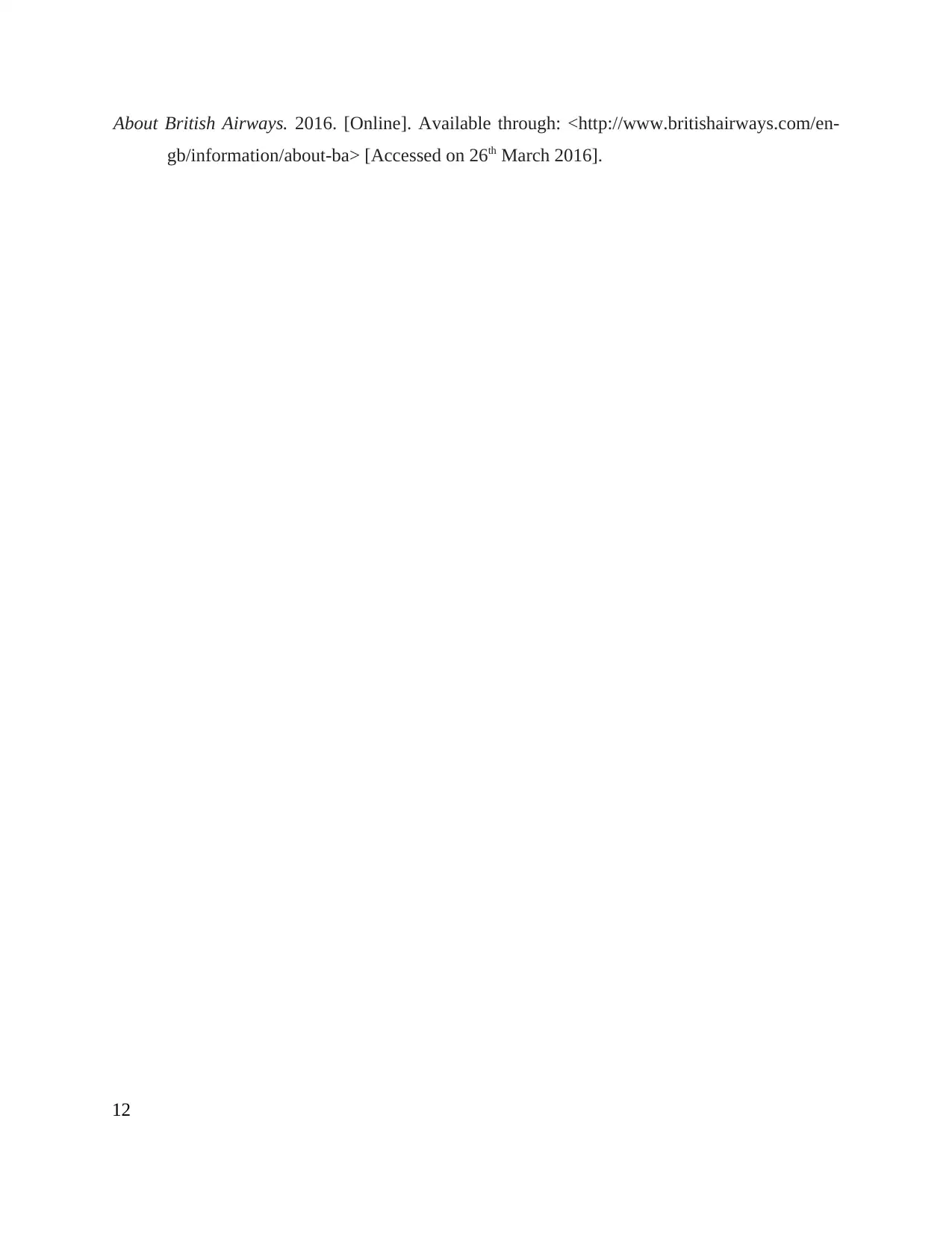
About British Airways. 2016. [Online]. Available through: <http://www.britishairways.com/en-
gb/information/about-ba> [Accessed on 26th March 2016].
12
gb/information/about-ba> [Accessed on 26th March 2016].
12
1 out of 12
Related Documents
Your All-in-One AI-Powered Toolkit for Academic Success.
+13062052269
info@desklib.com
Available 24*7 on WhatsApp / Email
![[object Object]](/_next/static/media/star-bottom.7253800d.svg)
Unlock your academic potential
© 2024 | Zucol Services PVT LTD | All rights reserved.





